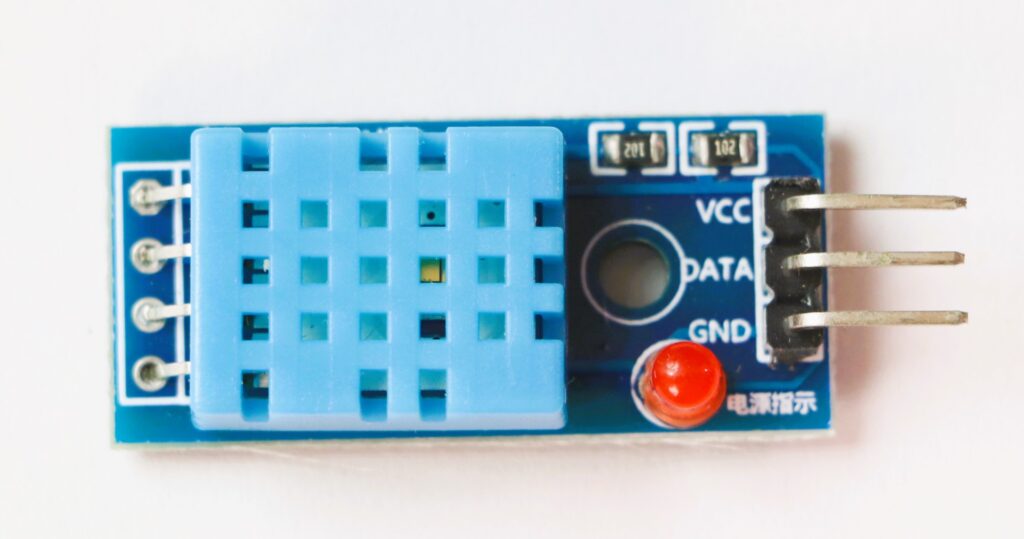Uncategorized
Everything About Humidity Sensor
Why we need Humidity Sensors
Humidity sensors are used in a variety of applications to measure the moisture content in the air. The most common type of humidity sensor is the hygrometer, which measures the amount of water vapour in the air. Hygrometers are used in weather stations, greenhouses, and other applications where accurate humidity measurements are essential.

Other types of humidity sensors include Relative Humidity (RH) sensors, which measure the amount of water vapour in the air relative to the temperature of the air; and Absolute Humidity (AH) sensors, which measure the actual amount of water vapour in the air.

Humidity sensors are important in many applications because the amount of water vapour in the air can significantly impact the performance of electronic equipment, the comfort of people, and the growth of plants.

Pinout Of Humidity Sensor

What is Humidity Sensor
Humidity sensors are used to measure the amount of water vapour present in the air. There are many different humidity sensors, but the most common type is the hygrometer. Now A hygrometer is an instrument used to measure the amount of water vapour in the air, in soil, or in closed areas.
The most common type of hygrometer is the psychrometer, also known as a wet-bulb/dry-bulb thermometer. It consists of two thermometers, one with a dry bulb and one with a wet bulb, that is exposed to the air. The air temperature is read from the dry bulb thermometer, while the wet bulb thermometer measures the temperature of the air after it has been cooled by the evaporation of water from the wet bulb. The difference between the two temperatures is used to calculate the humidity.

Video Demonstration
= = = = = =
Types of Humidity Sensor( DHT11 & DHT22 )

The DHT11 is a basic, low-cost digital temperature and humidity sensor. It uses a capacitive humidity sensor and a thermistor to measure the surrounding air. The DHT11 is often used in weather stations and horticultural applications.
The DHT22 is a more expensive, higher-precision version of the DHT11. It uses a digital signal processing technique to achieve higher precision and lower power consumption. The DHT22 is often used in industrial and scientific applications.
The main difference between DHT11 and DHT22 is that DHT11 is a basic temperature and humidity sensor while DHT22 is a more expensive, higher-precision version of DHT11.
The DHT11 sensor measures temperature in the range of 0-50°C with an accuracy of ±2°C. whereas the DHT22 sensor measures temperature in the range of -40-80°C with an accuracy of ±0.5°C.
The DHT11 sensor measures humidity in the range of 20-95% with an accuracy of ±5%. whereas the DHT22 sensor measures humidity in the range of 0-100% with an accuracy of ±2%.
The DHT22 sensor has a lower power consumption as compared to the DHT11 sensor.
The DHT11 sensor is slower than the DHT22 sensor.
The DHT11 sensor costs less as compared to the DHT22 sensor.
The DHT22 sensor is more precise as compared to the DHT11 sensor.
The DHT11 sensor is not recommended for industrial applications because of its low accuracy. The DHT22 sensor is recommended for industrial applications because of its high accuracy.
Features of Humidity Sensor
There are many different types of humidity sensors, each with its own unique features. Some common features of humidity sensors include:
-The ability to measure relative humidity (RH)
-The ability to measure absolute humidity (AH)
-The ability to measure dew point temperature
-The ability to measure wet-bulb temperature
-The ability to measure the vapour pressure
-The ability to measure the humidity ratio
-The ability to measure specific humidity
-The ability to measure enthalpy
-The ability to measure the density
-The ability to measure the partial pressure of water vapour
-The ability to measure water activity
-The ability to measure conductivity
-The ability to measure capacitance
-The ability to measure resistance
-The ability to measure thermal conductivity
-The ability to measure optical properties
-The ability to measure the mass
-The ability to measure surface tension
What advantages of Humidity Sensors?
Some advantages of humidity sensors include their ability to:
-Detect and measure the amount of water vapour in the air
-Help regulate indoor humidity levels
-Prevent mould and mildew growth
-Protect electronic equipment from corrosion
-Ensure comfort in indoor environments
-Reduce static electricity
-Maximize the efficiency of HVAC systems
-Improve air quality
-Reduce energy costs
-Extend the life of building materials
-Monitor environmental conditions
-Improve agricultural production
-And more!
Want to Buy it click Here

